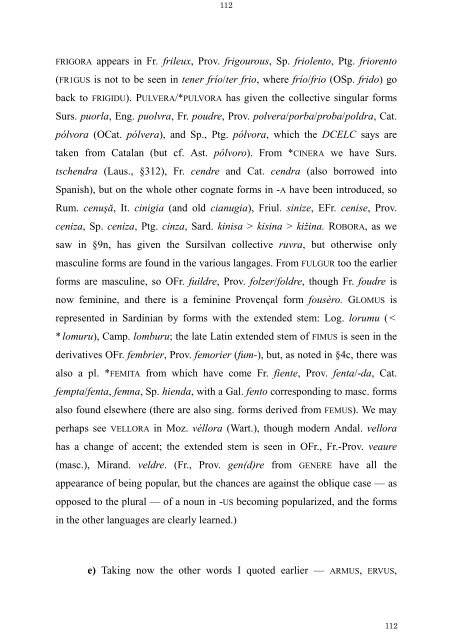The Latin Neuter Plurals in Romance - Page ON
The Latin Neuter Plurals in Romance - Page ON
The Latin Neuter Plurals in Romance - Page ON
Create successful ePaper yourself
Turn your PDF publications into a flip-book with our unique Google optimized e-Paper software.
112<br />
FRIGORA appears <strong>in</strong> Fr. frileux, Prov. frigourous, Sp. friolento, Ptg. friorento<br />
(FR1GUS is not to be seen <strong>in</strong> tener frío/ter frio, where frío/frio (OSp. frido) go<br />
back to FRIGIDU). PULVERA/*PULVORA has given the collective s<strong>in</strong>gular forms<br />
Surs. puorla, Eng. puolvra, Fr. poudre, Prov. polvera/porba/proba/poldra, Cat.<br />
pólvora (OCat. pólvera), and Sp., Ptg. pólvora, which the DCELC says are<br />
taken from Catalan (but cf. Ast. pólvoro). From *CINERA we have Surs.<br />
tschendra (Laus., §312), Fr. cendre and Cat. cendra (also borrowed <strong>in</strong>to<br />
Spanish), but on the whole other cognate forms <strong>in</strong> -A have been <strong>in</strong>troduced, so<br />
Rum. cenuşă, It. c<strong>in</strong>igia (and old cianugia), Friul. s<strong>in</strong>ize, EFr. cenise, Prov.<br />
ceniza, Sp. ceniza, Ptg. c<strong>in</strong>za, Sard. k<strong>in</strong>isa > kis<strong>in</strong>a > kiž<strong>in</strong>a. ROBORA, as we<br />
saw <strong>in</strong> §9n, has given the Sursilvan collective ruvra, but otherwise only<br />
mascul<strong>in</strong>e forms are found <strong>in</strong> the various langages. From FULGUR too the earlier<br />
forms are mascul<strong>in</strong>e, so OFr. fuildre, Prov. folzer/foldre, though Fr. foudre is<br />
now fem<strong>in</strong><strong>in</strong>e, and there is a fem<strong>in</strong><strong>in</strong>e Provençal form fousèro. GLOMUS is<br />
represented <strong>in</strong> Sard<strong>in</strong>ian by forms with the extended stem: Log. lorumu ( <<br />
* lomuru), Camp. lomburu; the late <strong>Lat<strong>in</strong></strong> extended stem of FIMUS is seen <strong>in</strong> the<br />
derivatives OFr. fembrier, Prov. femorier (fum-), but, as noted <strong>in</strong> §4c, there was<br />
also a pl. *FEMITA from which have come Fr. fiente, Prov. fenta/-da, Cat.<br />
fempta/fenta, femna, Sp. hienda, with a Gal. fento correspond<strong>in</strong>g to masc. forms<br />
also found elsewhere (there are also s<strong>in</strong>g. forms derived from FEMUS). We may<br />
perhaps see VELLORA <strong>in</strong> Moz. véllora (Wart.), though modern Andal. vellora<br />
has a change of accent; the extended stem is seen <strong>in</strong> OFr., Fr.-Prov. veaure<br />
(masc.), Mirand. veldre. (Fr., Prov. gen(d)re from GENERE have all the<br />
appearance of be<strong>in</strong>g popular, but the chances are aga<strong>in</strong>st the oblique case — as<br />
opposed to the plural — of a noun <strong>in</strong> -US becom<strong>in</strong>g popularized, and the forms<br />
<strong>in</strong> the other languages are clearly learned.)<br />
e) Tak<strong>in</strong>g now the other words I quoted earlier — ARMUS, ERVUS,<br />
112









